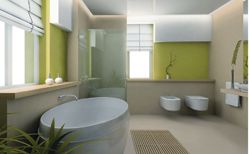Lee Nurse, marketing manager at Vent-Axia, explains how continuous decentralised ventilation can be retrofitted to help homes meet efficiency and carbon reduction targets.
Thanks to the Decent Home programme which has helped improve public sector homes in recent times, we now understand more about building performance than ever before. As a result, we are able to develop sympathetic ventilation systems which are designed to fit not just our homes but also the way people live their lives.
Air infiltration, especially in our existing housing stock, will occur naturally and this can be used successfully as air replacement to aid ventilation systems. However, traditional intermittent ventilation systems (see graph below) often provide peaks of high extract airflow which exceeds the natural infiltration rates. This means we are warming indoor air and extracting it to the atmosphere, which is not energy efficient.
Instead, new continuous ventilation systems are designed to work with the natural air infiltration and control the air path from the building thus preventing the migration of damaging humidity and pollutants. This can be achieved by using continuous low speed running extract fans in the wet rooms (bathrooms, kitchens and utility rooms) with a boost via the light switch, an integral pull cord or sensor when higher ventilation rates are required.
By providing ventilation in this way the extract systems can run at a much lower rate all the time, rather than at a high rate for one or two hours a day. As a result the systems are energy efficient, so reducing unnecessary heat loss and saving on carbon and fuel bills for homeowners. Meanwhile, the lower speeds mean very low noise levels which in turn means homeowners will be unaware that fans are running continuously. Finally, there are no trickle vents required as the low rates mean that adequate replacement air is available naturally.

The latest fans, such as, Vent-Axia's Lo-Carbon Centra, provide a near silent dMEV solution with the lowest specific fan power in its class. The Centra, for example, complies with Building Regulations Part F for continuous mechanical extract ventilation (System 3) and is capable of achieving up to 80 per cent energy savings and a 62 kg carbon reduction, so offering homeowners not only literal peace and quiet, but also peace of mind that electrical bills won't hit the roof.
By incorporating the latest Lo Carbon DC motor technology, the Centra extract fan delivers the lowest specific fan powers in its class. Offering virtually silent operation, a fresh design and a reduction in the requirement for trickle ventilators, this type of fan not only helps improve efficiency, but fits discreetly in modern homes and is simple to install.
Ideal for retrofitting as low energy ventilation into bathrooms, Centra is one element in Vent-Axia's decentralised ventilation solutions. Meanwhile, for demanding kitchen environments, contractors can select Vent-Axia's Quadra domestic fan suited to through-the-wall or ducted applications.
The multi-purpose Quadra meets the requirements of Building Regulations Part F for intermittent fans (System 1) and continuous mechanical extract ventilation (System 3). It provides a guaranteed installed performance thanks to an innovative switch 'n fit feature in the fan and features a range of advanced control options to boost efficiency, and ease installation and commissioning.
Trickle and Boost speeds can be set at installation within an airflow range extending from 6 l/s to 60 l/s. Quadra also features an integral adjustable overrun timer, delay on timer and self-programming humidity sensor. Operation can be further enhanced through the addition of a variety of Plug-'n'-Play automatic detection sensors.
With its single 100 mm spigot, filterless design and removable motor cassette, Quadra is simple to install and maintain. It will also fit existing ducts, whatever the size, making it ideal for replacement applications.
Compared with traditional intermittent ventilation options, the continuous ventilation technology now available is energy efficient, near silent in operation, simple to use and discreet. That's why a de-centralised continuous ventilation system using products such as Centra and Quadra today offers contractors a clear route to reducing carbon emissions and improving energy efficiency in our existing housing stock.
Vent-Axia
0844 856 0590